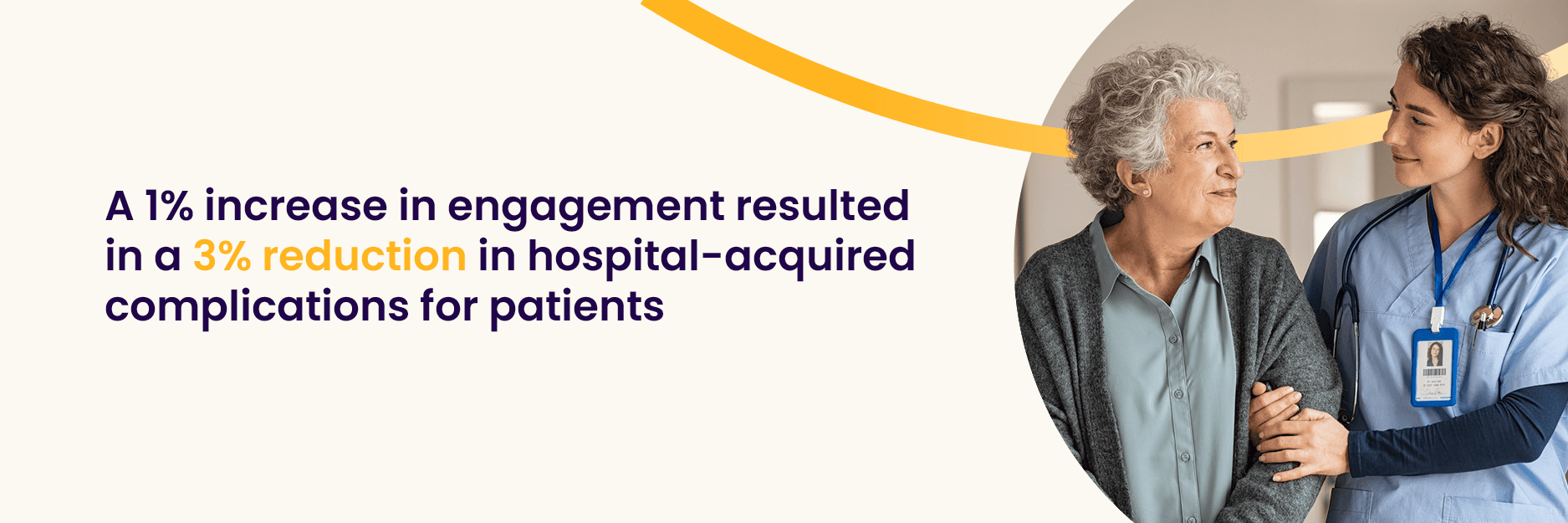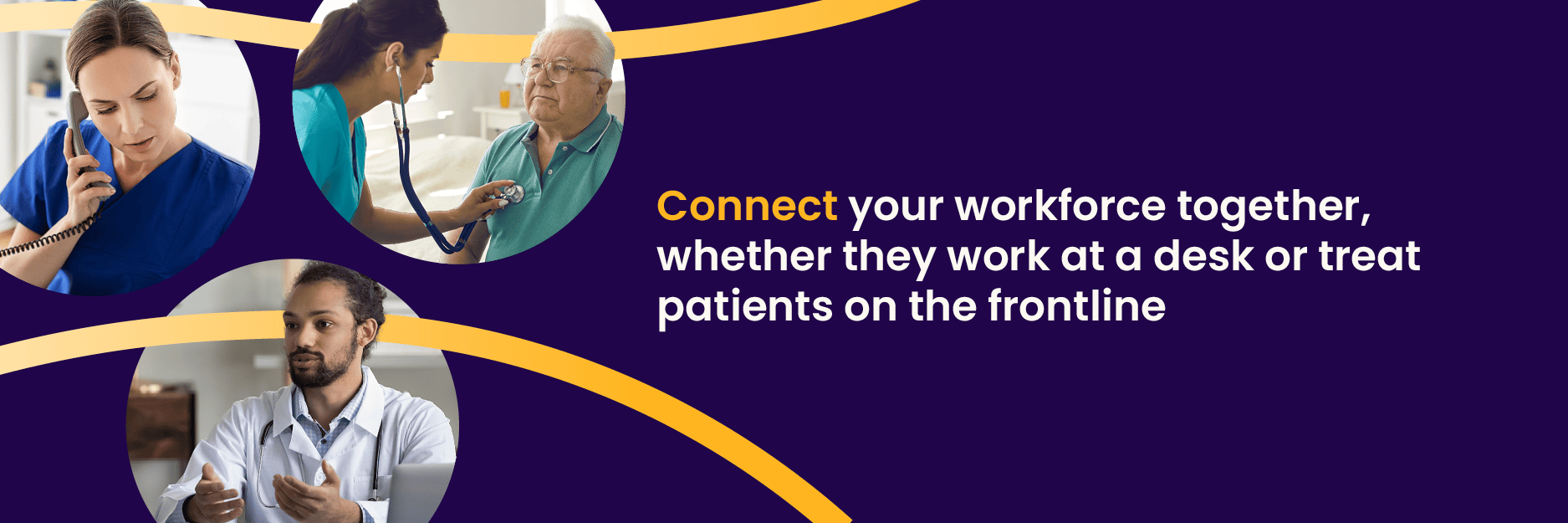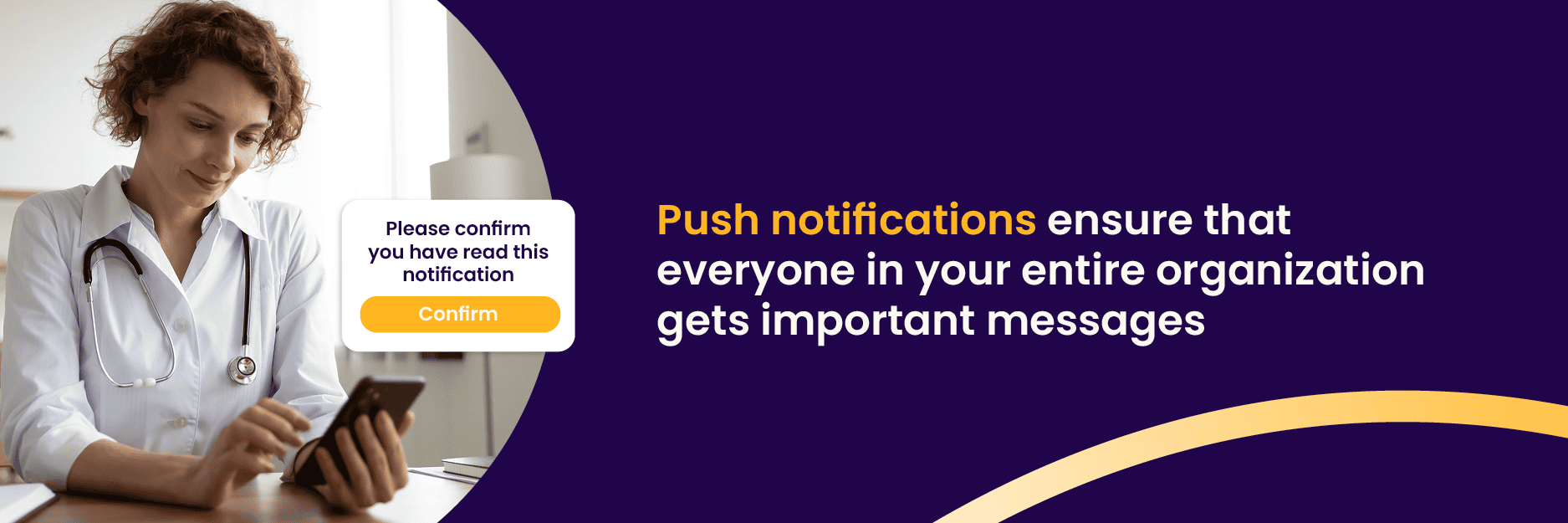Internal Comms for Healthcare – The Ultimate Guide

Lisa Ardill
Content Editor at Workvivo
24 Nov 2022

79% of healthcare workers say shortages have made their jobs harder since the pandemic began. Transform how you engage and communicate with your own employees with the ultimate guide to internal comms for healthcare.
The COVID-19 pandemic has put immense pressure on the healthcare system in almost every country in the world. The industry is facing huge staff shortages, with 79% of healthcare workers saying shortages have made their jobs harder since the pandemic began.
Employee mental health in the healthcare sector is also plummeting: in a study from April 2021, 49% of frontline healthcare employees said they felt anxious at work, while 55% reported feeling burned out. And another report from this year suggests things aren’t getting any better: 31% of clinicians said they planned to leave their current role in the next two to three years. Of those, 39% plan to quit the profession altogether.

All of this means that it’s more important than ever for healthcare organizations to develop solid communication strategies that boost engagement, improve morale, and decrease staff turnover.
But here’s the thing: healthcare professionals are notoriously difficult to reach with traditional internal comms. Many workers are deskless, which means they can’t easily spend time browsing through a company intranet or corporate newsletter. They might work across multiple facilities, which can make it difficult to even keep up with emails.
Think about it: are your healthcare employees feeling good at work, or are they teetering on the edge of burnout? Without a well-planned, well-executed internal comms strategy, you have no way of knowing.
What is employee internal communications?
Employee internal communications is an umbrella term that covers all the ways that organizations communicate with their employees. This includes traditional top-down communications like corporate newsletters or emails, and more modern, worker-focused techniques like employee listening, feedback loops, and peer-to-peer recognition.
Why is internal communications important in today’s workplace?
Without internal communications, your employees would have no idea about essential policy updates or legislation changes affecting your industry. More broadly, you would have no way of getting your brand values, mission, and strategy across to your employees – and your employees would have no way of giving you feedback on how your organization is running.
Simply put, internal communications are a vital part of any organization – especially in the context of the Great Resignation. As we discussed back in May, it’s getting harder and harder for employers to attract and retain top talent. These days, companies need to do more to actively engage their employees and attract new ones in a competitive market.
A well-thought-out, targeted internal communications strategy can:
- Boost employee engagement and productivity: Employees are likely to be more engaged in their work if they know they’re working together towards a common goal. Plus, communications strategies that encourage employees to share their opinions help to make them feel valued, which is also a significant driver of engagement. According to a Salesforce survey, employees who feel their voice is heard are 4.6 times more likely to feel empowered to do their best work.
- Improve the employee experience and boost retention: When employees are engaged at work, they’re much less likely to look for another job elsewhere. A Gallup poll found that highly engaged employees were between 24% and 59% less likely to leave.

- Increase efficiency and solve problems more quickly: When a serious problem arises, do you want your employees to have to deal with it alone? Or to have access to a range of resources and team members who might be able to help them? An effective communications strategy connects your employees together so that they can solve problems quickly and work more efficiently.
- Save the company money: Poor communications in the workplace can have a devastating effect on the company’s bottom line: in an SHRM study of 400 companies with over 100,000 employees, the average company reported a loss of $62.4 million per year due to inadequate communication.
Despite all of this, 60% of organizations don’t have a long-term internal communication strategy in place. Even if you do, you still might fall short if you’re not embracing modern communication methods – especially where frontline workers like those working in healthcare are concerned.
The fact is, the old methods just don’t cut it: comms emails often go unread, and traditional intranet platforms are often clunky, outdated, and poorly used. And these methods are even more likely to fail in healthcare organizations, where many employees are deskless and don’t work out of the company HQ.
The challenges of internal comms for healthcare employees
According to Gallup’s State of the Global Workforce 2022 report, only 22% of employees are actively engaged at work, with 44% reporting that they feel stressed on a day-to-day basis.
And, while employee engagement is crucial in any industry, its impact can be felt particularly strongly in healthcare. Another study from Victoria, Australia found that just a 1% increase in engagement resulted in a 3% reduction in hospital-acquired complications for patients and a 7% decrease in hospital re-admissions.

The best way to engage your healthcare employees and reap these benefits is to develop a solid communication system that centers their voices, reflects your organization’s mission, and makes every employee feel valued. But sadly, many healthcare organizations are missing the mark here: according to a McKinsey survey from January 2022, more than 30% of nurses were thinking of leaving direct patient care, most often because they didn’t feel listened to or supported at work.
Reaching healthcare professionals with your internal communications is not impossible, but it does involve facing some unique challenges. Here are some of the reasons you may be struggling to get your message across.
- Deskless workers: Healthcare professionals might work across various different facilities or even make home visits to patients – which doesn’t leave much time to catch up on corporate communications. In fact, many might not even have time to check their emails very frequently since they’re so often on the go, which means important messages can be missed.
- Fragmented communications: Choppy, fragmented communications are never a good thing, but they could have serious consequences in a healthcare setting. According to one study, 80% of serious medical errors occur due to miscommunication during patient handovers. Fragmented communications also mean reduced efficiency: doctors, nurses, and other caregivers reportedly waste more than 45 minutes every day as a result of ineffective communication systems. At a time when 79% of workers report staff shortages are making their job more difficult, that’s 45 minutes they simply don’t have.
- Outdated technology: In the US, almost 80% of hospital doctors still use pagers to communicate with each other – and for good reason. Mobile signal is often not great in hospitals, and a pager is a reliable way to get a message to a colleague in an emergency. However, there’s a reason most of us left these devices behind in the ‘90s: they don’t allow for two-way communication, and certainly don’t provide opportunities for the types of culture-building, employee-centered communications that healthcare organizations need to keep their people engaged.
7 ways to connect with healthcare workers through your internal communications strategy
Healthcare employees are typically hard to reach with internal communications – but engaging them can have big results. In fact, improving employee engagement in healthcare settings has been shown to reduce hospital costs, increase treatment effectiveness, and decrease hospital-acquired infections.
Here are seven ways to reach your healthcare workforce through your internal communications strategy:
1. Bring communications together in one hub
Many healthcare organizations use a variety of different methods to communicate with their workforce. There may be a monthly newsletter that goes out by email, and a physical noticeboard to display important updates. In many hospitals, medical staff still use pagers to send urgent messages.
The problem with these methods is that, very often, you have no way of knowing whether the message has been received. They also don’t allow for two-way or cross-functional communication: if you leave a note about a new policy on a noticeboard, employees can’t comment with their thoughts. Eventually, this can leave people feeling disengaged and disconnected from your organization.
One solution is to bring your communications together into one hub, like an employee intranet. If you’ve used a corporate or school intranet before, don’t panic: we’ve come a long way from the clunky, web-based, and poorly used systems of the early ‘00s. Modern intranet solutions come with all sorts of features that allow you to connect your workforce together, whether they work at a desk or treat patients on the frontline.

2. Supplement the pager with a mobile app
As we’ve discussed, doctors in many hospitals still use pagers for urgent communications. In some cases, this is unavoidable: hospitals are often dead zones for mobile signal, and using a pager is often the only way to ensure that a message gets through.
However, even in these cases, using only pagers for your rapid and instant comms isn’t enough, because they don’t allow for two-way communications. And they’re certainly not set up for the sorts of long-form, motivating content that can really drive engagement.
So, here’s a compromise: keep the pagers for emergencies, and use a mobile intranet app for everything else. This way, your healthcare employees will be able to access their personalized news feed, share their opinions, and connect with their colleagues, wherever they are.
You could even take a leaf out of Walmart’s book and take it one step further: they rolled out a company intranet in 2019 and gave 740,000 employees a Samsung smartphone to make sure they could access it.
3. Segment communications to avoid information overload
When everything from new protocols to updated employee benefits to industry trend reports goes out to every employee, they’ll quickly get overwhelmed. And don’t forget, healthcare employees are busy – if you overload them with communications, there’s a good chance they’ll just ignore them altogether.
Instead, segment your audience. To ensure that the content each employee receives is highly targeted, personalized, and relevant, create some strict rules about what content should go to which employees. For example, important company announcements should go to everyone but thought leadership content or information that only affects one location probably doesn’t need to.
4. Break down silos and enable cooperative care
Very often when patients are treated by multiple doctors, nurses, and other healthcare practitioners, these professionals have little opportunity to communicate with each other. Healthcare decisions are often made by one person alone – who may not have all of the necessary context to understand the big picture.
Modern internal communications strategies in healthcare should provide opportunities for caregivers to communicate with each other in real time, instead of relying on emails (which often go unread) or pagers (which should only be used for urgent messages). By choosing a solution that allows for this, you can increase communication between different employees, and improve patient outcomes by enabling cooperative, collaborative care.
5. Make employee mental health a key focus
In a recent study, 60 to 75% of clinicians reported symptoms of exhaustion, depression, sleep disorders, and PTSD. With mental health for healthcare providers at an all-time low, it’s never been more crucial for employers to look out for their employees.This means not only providing the right resources but ensuring that employees know what support is available to them – which can only be achieved through internal communications.

You can also use your intranet or internal comms platform to share best practices for looking after mental health, and encourage employees to stick to them. Encouraging open communication – and leading by example – can also show employees that you take their experiences and their mental well-being seriously.
6. Give your employees a voice (and actually listen to them)
The most powerful communications don’t come from the top down. In healthcare in particular, it’s your frontline employees who really understand how your organization functions – and how it could be improved. Why wouldn’t you want to access those insights?
A good internal comms strategy can help you to empower your healthcare employees to provide feedback on how your organization is running. Ultimately, this can help you to create a more streamlined and efficient operation, provide better patient care, and minimize unnecessary risk.
But as we’ve discussed, healthcare workers are busy – so you need to make it easy for them. At the most basic level, a dedicated inbox where your employees can send their ideas for improvements could work, but a custom form that’s easy to fill out is much better. Depending on the intranet solution you choose, you might even be able to send out surveys and polls right within the platform.
You don’t have to implement every piece of feedback you receive, of course – but seeing their ideas taken seriously can have a powerful impact on employee engagement and retention.
7. Keep things positive (and even fun)
Employee communications shouldn’t be about stilted company updates coming from your senior leadership team. Apart from anything else, frontline healthcare professionals are busy, so there’s a good chance they just won’t open those emails.
Instead, good communication should connect and engage employees in the same way as social media. Consider stepping away from long pieces of content that your employees probably don’t have time for, and focusing instead on bite-sized formats that are more concise and engaging.
There are all sorts of ways to inject a bit of fun into your internal communications, from organizing regular competitions to asking employees to share photos of their pets in a dedicated channel. It all goes a little way towards engaging your workforce, helping them to feel valued, and bringing them together.
The must-have features for an internal communications platform
There are many parts to a good communication strategy. It needs to involve carefully crafted, well-branded content. It should also allow your entire workforce to contribute to the conversation, which requires careful planning as well. However, none of that will work if it’s not sitting on a powerful platform that’s designed to bring employees together.
There are many different platforms out there, and they all come with their own unique features – the one you choose will depend on the specific needs of your organization.
However, there are some key features that you shouldn’t compromise on. Here are some of the must-haves to look for when you’re choosing a platform:
- An intuitive and familiar interface: If you want your employees to actually use the platform you choose, you need to make sure it’s accessible and inviting. That means looking for solutions with an interface that’s pleasant and easy to navigate. This is especially important where healthcare workers are concerned since they typically don’t have time to learn the ins and outs of a whole new complicated program.
- A mobile app: If you want to engage your deskless workers in particular, you need to meet them where they are – which means looking for solutions that are accessible on a smartphone. More than this, the solution you choose should be mobile-first, not just a website that’s technically accessible on a smartphone if you turn your phone on the side and wait for it to load.
- Push notifications: In healthcare settings, there are times when you need to get a message out to your entire organization – and know they’ve received it. To get around this, use an app with a push notification feature. Then, when you need to announce a new compliance policy or safety protocol, you’ll know the message has gotten to everyone.

Pulse surveys and polls: Pulse surveys are a great way to keep an eye on what’s actually going on in your organization in terms of employee engagement. And you can use polls to get a quick snapshot of your employees’ opinions, for example when you’re looking to implement a new policy. This is a particularly effective tool for healthcare workers since they know better than anyone what life on the frontline of your organization is actually like. Often, things seem like a great idea in head office, and it takes someone on the ground to point out an obvious problem. Any communication platform you choose should make it easy for you to send out these surveys and polls and for even your busiest employees to respond.
- Opportunities for bottom-up and cross-functional communication: The most effective communication doesn’t come from the top down. To really empower your healthcare workers, you need a solution that allows them to communicate with each other regardless of location, discuss problems, and even connect on a social level. Bonus points if your platform has social media-like functions like comments and emoji reactions, which all help to make things more fun and engaging.
Introducing Workvivo
Workvivo is an employee communication platform with the power to bring your whole organization together – whether they’re at their desks or working with patients in a clinic, surgery, or hospital. Our platform helps your employees to communicate, share ideas, and better understand your organization’s core mission and values.
Employees from all parts of your organization can post updates, ask questions, and give shout-outs, and they’ll appear to other employees in a personalized news feed. Our employee recognition features can help you to build a culture of real-time, spontaneous peer-to-peer recognition. And you can easily send out polls and surveys that employees can respond to with just a few taps of the screen.
And did we mention? Our platform is fully accessible through our mobile app, which means it’s the perfect tool to engage every one of your workers – even those who don’t work behind a desk.
Want to learn more? Book a personalized demo to understand how Workvivo can help you supercharge your healthcare communications and set your organization up for success.